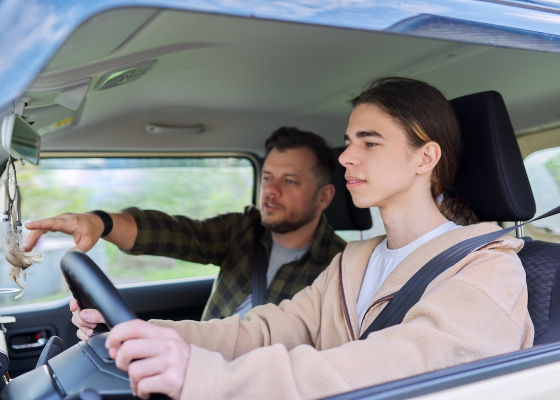Each year, millions of teenagers begin driving lessons so they can earn their driver's license and start experiencing more independence. For parents, this can be a stressful time as they worry about their teen's safety as well as potential damage to their vehicles.
Simply put, teenagers may be less experienced drivers but they can be taught to be safe drivers. In today's Aegis blog post, we look at six ways parents or relatives can help teach teenagers to be safe, responsible drivers and hopefully prevent costly accidents or painful injuries.
Model safe driving
The best way for teens to learn to be safe drivers is for adults to model safe driving for them. Teenagers will pick up the driving habits of grownups around them, both good and bad, so parents and other caregivers need to make sure they're setting good examples anytime they're driving with their teenager or younger kids.
To model good driving behavior, adults should always:
- Obey all traffic laws
- Wear a seatbelt
- Put cellphones away
- Avoid eating or applying makeup while driving
- Be patient while driving to avoid road rage
- Look for teachable opportunities
Teens can learn a lot from adults behind the wheel, so it's important to take advantage of teachable moments, such as what to do when being pulled over, how to move over for first responder vehicles, and how to handle yield signs or roundabouts. Through modeling safe driving, adults can give their teens a more solid driving foundation, enabling them to make better choices behind the wheel.
Put down smartphones
One of the biggest issues for teen drivers is the temptation to use their cell phones while driving, making them distracted and dangerous drivers. Adults should stress to teens the importance of putting cell phones away while driving, and only using them when they are parked or pulled over in a safe location.
Also, many newer vehicles have integrated tech systems that connect to smartphones, allowing drivers to use voice activation to make calls or respond to texts without having to take their eyes off the road. Teens should be taught to use hand-free technology whenever possible to avoid touching their cellphone when driving so they can be focused on the road ahead.
Rely on vehicle navigation systems
A growing number of vehicles also have navigation or GPS systems built in, which can also help teens who might not be familiar with local highways and side streets. Adults should teach teen drivers how to use car navigation systems, and more importantly, to set destination addresses before they pull out of the driveway.
Using navigation systems and inputting destination addresses early can help reduce the temptation for teens to use their cellphones while driving. Also, it can ensure they arrive at their destination safely and don't get lost or make unsafe driving decisions out of panic.
Limit driving hours and passengers
Another way parents and other adults can encourage good driving behavior is to limit the number of passengers in the vehicle with their teen. Teen drivers are easily distracted drivers because of their inexperience, and having a car full of loud, talking teens with them can lead to accidents or injuries.
Parents and caregivers should set rules about the number of teen passengers in the car with them to avoid distracted driving, and should also set hours for driving to avoid late night driving when visibility is reduced. The number of red-light crashes and drunk driving incidents rises sharply at night, so teens should be encouraged to be off the roads during those late-night hours.
Teach emergency guidelines and car maintenance
Teens should be taught early and often the importance of emergency guidelines while driving. Teens should know what to do in the event of an accident, how to safely pull over if the vehicle stalls or has a flat tire, and who to call for help, such as a parent or roadside assistance.
Teen drivers should also know basic car maintenance, like monitoring gas levels to ensure they don't run out of gas while driving, getting oil changes on a regular basis, how to change a flat tire, and checking tire pressure. Adults should also ensure that teens have a car maintenance kit in their vehicle at all times, and that they know how to use the items in it, such as jumper cables or temporary tire repair kits.
Explain the importance of Auto Insurance
Finally, parents and caregivers should stress the importance of Auto Insurance to their teen drivers, and how it protects and provides in the event of an emergency. Teens should also learn how having a safe, clean driving record can make a positive impact on their insurance rates for the years ahead.
When teens understand the importance of Auto Insurance and how their driving impacts their future coverage, they're more likely to make smarter driving decisions to protect themselves and their vehicles. Teens should also be taught the different types of Auto Insurance coverages so they know what kind will be right for them as adults.
Teens should learn the policy differences between:
- Comprehensive
- Collision
- Liability
- Underinsured/Uninsured Motorists
- Personal Injury Protection
How Aegis Can Help
Learning to drive is an exciting rite of passage for teenagers, but when adults take the time to teach them safe and responsible driving, it can provide peace of mind and help them avoid deadly accidents or costly vehicle damages. Aegis Insurance & Financial Services can also help parents protect their teen drivers through our different Auto Insurance policies.
Contact Aegis today to learn more about our Personal Auto coverage options by calling our office at 713-850-7622, or filling out our online form for a free quote!

